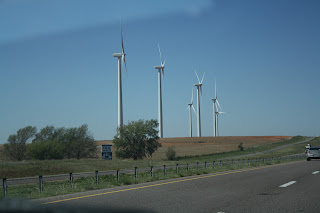"And by the time we get there, it will probably be winter," I added.
 |
| Here, on the road to Clinton, most the the wind turbines stand silent, in spite of the breeze. |
"Goodie!" I answered sarcastically.
Once we left Oklahoma City the countryside looked like Oklahoma should look--vast fields stretched as far as we could see, with occasional herds of Black Angus or Herefords, and periodic oil wells, pumping rhythmically up and down. Drilling rigs on the horizon exclaimed, "Oil here!" Ponds, some still clear, were very low. Andy read that in the last two years, the rainfall has been 15 to 25 inches below normal. The drought hasn't lifted here, at least not enough, even after the hurricane came through. Only when the highway swelled upward did we see trees.
At Cherokee about ten cattle trucks stopped for gas. Some were empty, but we could still hear lots of mooing.
"You know," said Andy, "I don't know whether I could even drive one of those trucks, knowing where they are headed."
"I couldn't," I told him, Just then a cow put his nose out one of the openings. "I feel a terrible lump in my stomach whenever I see a loaded truck. Life is so short and fragile," I said.
"Yeah," he agreed, "and life is especially short for them."
At Red Rocks State Park in Hinton,Oklahoma, we took the California Road Nature Trail for a mile or two. First it climbed up red sandstone cliffs and followed a cedar grove. All the trees were dry and dead. When it crossed the stream to the other side of the canyon, the cedars sustained life and squirrels abounded. Piles of loose red dirt dotted the grass in five major picnic and camping areas. Apparently, moles thrive here, as well.
 |
| Dotted gayfeathers, called aotashe by the Omaha and makan-sag by the Ponca, color the landscape. |
As we got closer to Clinton, we saw more and more fields of wheat.
Dotted gayfeather flowers were used by the American Indians as medicine. The roots treated abdominal and urinary problems, and the Pawnees used roots and leaves to cure children's diarrhea.
 |
| A beautiful sand beach extends along the North shore of the reservoir at Foss State Park. |
Fire danger at Foss State Park was extreme, and there was a ban on all burning. The reservoir, formed from the damming of the Washita River, created a huge lake for boating and fishing and a massive docking area. There were some lovely camping facilities on both sides of the lake. Unfortunately, the water level was seriously low.
 |
| Abandoned houses stand lonely on the rises in this ranch country. |
"Nine out of ten, the neighbor bought him out," Andy answered. "Too bad there aren't a few clouds to set off that gorgeous blue sky." We stopped for a photo. We actually stopped twice more at abandoned farms as we drove around the countryside and then headed back toward Clinton.
 |
| As in this case, many of the abandoned houses have adjoining property that is still being farmed. |
Centennial Trail, buried in a pullout, followed an overgrown path and boardwalk to a wetlands observation platform, a third of a mile in. The entire area was bone dry. Andy and I made a game of stepping on grasshoppers, a task much harder than one would think. Of the thousands, we got eight and a stink bug.
We had had a lovely day of limited activity! ...in spite of our hikes.
"Is your restaurant always this busy on a Tuesday night?" we asked the waitress at Palacio's Mexican Grill in Clinton.
Local people streamed in the whole time we were there, and we had selected the place at 5:30 p.m. because the front parking lot was already filled with trucks.
She nodded and grinned; the other waitresses all dashed this way and that, serious-faced or scowling in concentration.
"It seems like chaos. The waitresses run every which direction," Andy said to me.
"We can't get over all the people on a Tuesday night," he told the waitress.
"Yes," she answered. "We've been open two nights."
It was a testament to job creation.
No comments:
Post a Comment